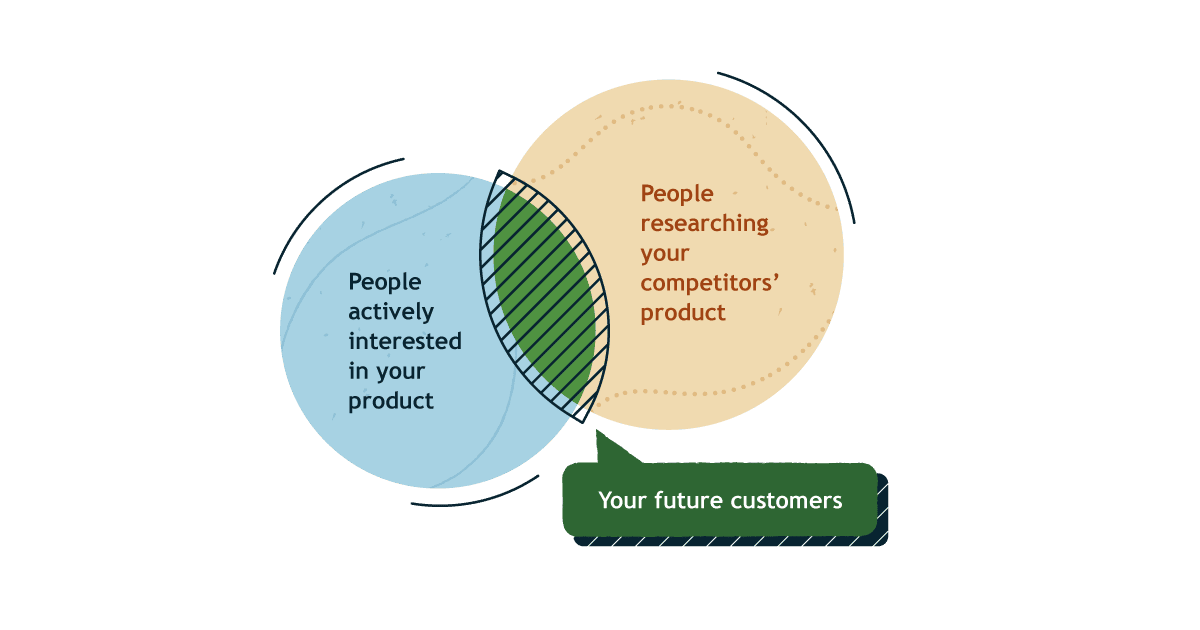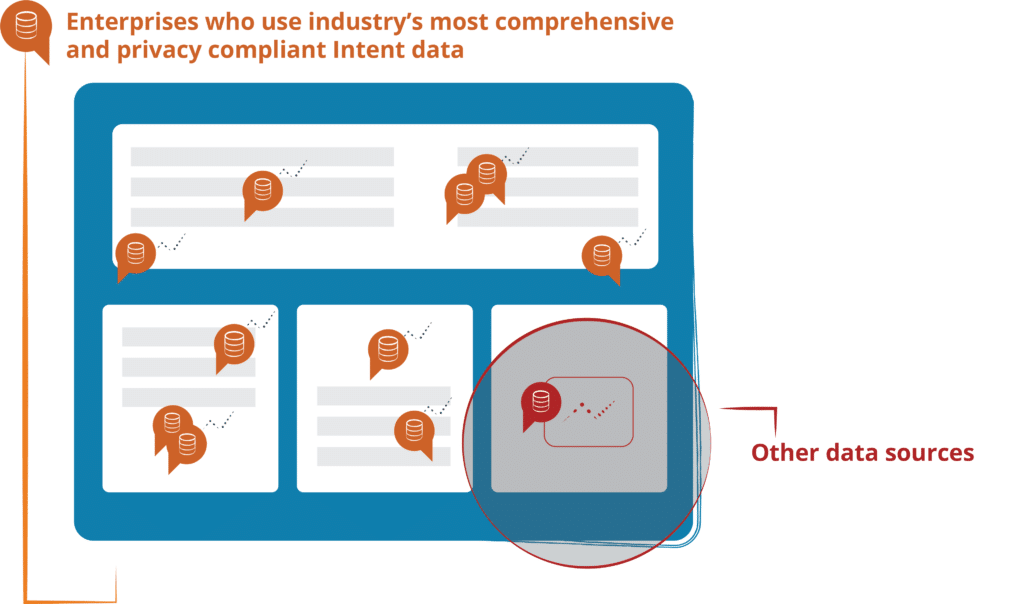Why Intent data is critical for your 2023 enterprise marketing performance
Intent data can answer pivotal questions for B2B marketers — if you read the meaning of Intent data correctly. If you’re getting jitters about an economic slowdown in 2023, you may find Intent data is just what you need.
The right Intent data and martech stack can tell you why people buy. Measuring Intent right helps you laser-target content, ad campaigns, and account-based marketing (ABM) to the people most interested in your products and services. Measuring Intent wrong wastes time, effort, and money while handing an advantage to more Intent-savvy competitors.
But where does Intent data come from? For starters, there’s first-party data from your website analytics revealing page views and conversions. But you’ll learn even more if you converge these insights with third-party data from people researching products throughout the B2B internet.
Third-party data can seem like a minefield at first glance. For instance, bidstream data from online advertising exchanges is timely and abundant but also noisy and unreliable. Enterprises need tools explicitly designed to cut through the noise and give access to actionable Intent signals that matter the most.
To build resilient growth, enterprises are far better off analyzing another kind of third-party data: Intent signals from people conducting in-depth research while reading online reviews and trade magazine articles. Careful analysis of Intent data that’s specific to highly trafficked B2B websites can reveal the strength of buyer Intent and give you actionable guidance on having better conversations and closing more sales.

The type of Intent data enterprises need
Bidstream data comes from online advertising auctions. It reveals a few valuable characteristics of a display ad on a webpage, like time of day, URL, location, and keyword. But this data doesn’t say much about why a prospect or customer is on that page or what they learned while visiting it.
“You don’t really know where people’s eyes were on that ad, where they clicked, or whether anybody actually paid any attention to the ad,” said Elena Drozd, vice president of data science with Bombora, which specializes in providing the cleanest Intent-data solutions.
Bombora takes a more sophisticated third-party approach through a solution called Company Surge®. And the data comes from the only fully consent-based data co-op of more than 5,000 publishers whose readers agree to the anonymous collection of data about their activities on the publishers’ sites. Bombora provides Intent insights from this data to its clients.
“This is a huge differentiator from bidstream data, especially in places where consumer consent is paramount,” Drozd said. Consent is essential to compliance with regulations designed to give internet users a choice in using their data.
Company Surge® captures more than 12,000 topics covering a vast swath of business activities. When somebody visits a co-op member’s website, a special code inserted in the site’s pages generates signals that Bombora’s technology interprets.
Natural language processing (NLP) algorithms interpret these signals by correlating the content of a webpage to Bombora’s massive topic list. This gives Bombora customers nuanced buyer-Intent metrics that bidstream’s ambiguous data points cannot provide.
Using topic clusters to boost marketing performance
Bombora divides its 12,000+ topics into these clusters:
- Themes
- Categories
- Topic names
- Descriptions
Themes are macro industry sectors like biotechnology or consumer technology. Categories are subthemes within these sectors like agritech or smartphones. Each subtheme has multiple topic names, and each topic name has a description.
How do these topic clusters work? Let’s say you operate a winery in California’s Napa Valley and you’re looking for new soil-analysis software to improve your grapevine yield. You’ll buy this software from an agricultural technology firm in the biotech sector.
Bombora anticipates that you’ll research this software online long before you buy. Its topic list includes your software’s relevant subcategories plus a one-sentence description of soil analysis (assessing nutrient content and other factors).
When you visit one of Bombora’s 5,000+ co-op websites to learn more about soil-analysis software, Bombora gets a signal revealing the pages you visited, the topics you’ve read about, and other data points that provide a clearer picture of the buyers’ journey.
This is where things get interesting: Bombora’s high-powered NLP machine-learning algorithms use these co-op data signals to help soil-analysis software vendors target their marketing messages to people like you — not casual web surfers but those who want to buy their products.
Bombora Company Surge® correlates third-party co-op data with all those product subcategories and descriptions. Best of all, it merges these insights with first-party signals from website analytics and integrates them with popular marketing-automation platforms. The signal is recent (this week vs. last month) and reliable.
Hushly saw a 498% jump in CTR (compared to using LinkedIn targeting alone) while seeing a 79% reduction in cost per click (CPC). And using Bombora’s Intent data, Salesforce achieved a 271% ROI on paid social.
“This is what makes Bombora data actionable,” Drozd said. “It’s a signal that covers all of the marketing funnel and sales funnel stages.”
Effectively implementing Intent data for success
Let’s take a quick snapshot of what we’ve covered so far. Bombora Company Surge®:
- Collects buyer-Intent signals from more than 85% of the most highly trafficked B2B internet
- Aligns these signals with more than 12,000 industry topics
- Correlates first-party data from your company’s website analytics
- Integrates with popular marketing automation platforms like Salesforce and Marketo
Of course, it’s not enough to gather these data signals. You must know how to make them actionable — especially if the economy looks bleak. Company Surge® does this by flagging unexpected, out-of-bounds Intent signals pointing to trends you can exploit without delay.
“Every company produces data revealing baseline behaviors, but that’s not what we’re selling to customers,” Drozd said. “We look for abnormalities in the data: once-in-a-blue-moon signals indicating that people are doing extensive research and thus entering the buying cycle.”
Armed with this data, marketers can launch a new email sequence to specific buyers while they’re researching your company. An ABM campaign can be redirected to the people most deeply involved in buying decisions within an enterprise.
Sales reps can also see the topics your key accounts have been researching in the past few days. This can help them connect with target customers and land in-person meetings with decision-makers with the right messaging at the right time. Similarly, customer success managers can use this data to drive product adoption, manage contract renewals, and identify upsell opportunities.
Expanding your total addressable market with Intent data
Successful enterprises understand the boundaries of their total addressable market (TAM). But they might not realize their TAM is getting bigger as new buyers are interested in them.
This is understandable. If you sell dashboard touchscreens to Toyota and General Motors, you know your TAM consists of major auto manufacturers. But what if a new electric-car startup with millions in fresh venture capital funding is researching your touchscreens? You might see the company’s domain name pop up in your website analytics for a few days, but would you know what the signals mean?
Bombora Company Surge® gives you answers with a team of experts to help you make sense of all that data.
“You get exposed to data much earlier in the buying stage,” Drozd said. “It also lets you focus the money of your programmatic campaigns only on companies active in the research phase. This precise targeting shows companies you normally wouldn’t see, which broadens your TAM.”
You can also take this data to your content-marketing team to suggest ideas for blog posts, ebooks, whitepapers, infographics, and other collateral.

Critical challenges to adopting Intent data
If Intent data is so awesome, why is there some hesitation in adoption? Drozd said that in Bombora’s case, the challenge is not especially technical. Integrations to Marketo and Salesforce, the two biggest marketing automation platforms, are built into Company Surge®.
“The largest challenge is selling the value of Intent data to your leadership, helping them believe the data will actually work and it will be money well spent,” Drozd said.
What’s key is to start small and demonstrate that it can make people’s work easier. Try A/B testing and proof-of-concept projects, she suggested.
It can be complicated to figure out which topic clusters provide clients with the most actionable Intent data. Bombora resolves these issues by running a historical buyer journey analysis to align topics with a client’s unique needs. It’s an iterative process bringing together data scientists and customer experience teams. All this gets worked out when Bombora onboards a new client.
Putting Intent data to work in 2023
Let’s return to the Napa Wine Country. A small startup in San Francisco that designs soil analysis software has gotten a toehold selling to Napa wineries. They want to be ready if demand softens in a slower economy and pivot quickly if new opportunities pop up.
Meanwhile, across the country in Virginia and the Carolinas, tobacco farmers are converting to wine production amid a broad decline in cigarette smoking. They’re hoping the latest soil-analysis software gives them an edge in figuring out which grapes produce the best wines for their markets.
If the San Francisco startup uses Company Surge®, they don’t have to wait for these farmers-turned-vintners to show up in their first-party website analytics. Bombora’s algorithms can flag these potential customers beforehand.
“This tells them it’s time to enter into the marketing communication or sales engagement with these buyers,” Drozd said.
That’s the modern, precision-guided insight that enterprise marketing teams will need in 2023.



